A Pet Parent's Guide to Caring for Your Dog or Cat
Pets bring happiness and love to our lives. Studies from the Human Animal Bond Research Institute show that caring for a pet has numerous physical and mental health benefits, as well as positive effects for older or aging adults. Adding a pet or companion animal to your family can:
- Help alleviate stress, worry, and depression
- Encourage regular activity
- Combat loneliness and reduce pain and discomfort
This guide will help you prepare for your life as a pet parent. It will cover topics including setting up their new environment, learning how and where to start your search, and providing an overview of what your new dog or cat will need to be a happy and healthy pet, and into their final stage of life.

Choosing the Right Pet for You
What to Consider
When bringing home a new pet, you’ll need to choose one that is right for you. Your new companion will arrive with needs and quirks that should fit well into your lifestyle. Dogs and cats have different needs, which should be carefully considered before getting one.
Answer these questions as you think about the time and space you have to care for your new pet, both now and in the future:
- Can you afford the costs of caring for your pet, including veterinary care?
- How long will you be away from your pet? Do you work long hours or travel frequently?
- Who will care for your pet in your absence?
- What future changes might occur in your living situation or lifestyle that would affect your ability to keep your pet in years to come?
- Do local laws or your housing arrangement limit your choice of pet or number of pets?
- Are you able to provide the amount of attention or exercise your pet will need?
- How many years are you willing to commit yourself to care for a pet?
- Do you already have any pets? If so, will your current pet accept another pet of the same or a different species?
- What are you looking for in a pet? To lounge with you at home or go on rigorous runs with you?
- Will you be able to manage their grooming needs?
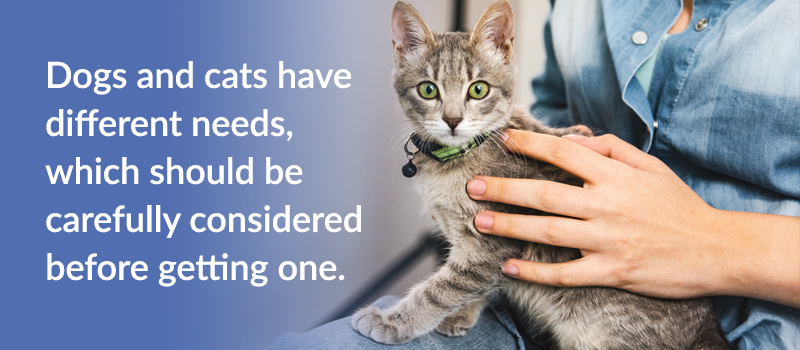
Household Recommendations
To keep everyone safe and healthy at home, keep these suggestions in mind:
- Households with children under 5 years of age should not own reptiles, such as turtles, or amphibians, such as frogs, because of the risk of salmonella.
- Pregnant women should avoid contact with pet rodents to prevent exposure to lymphocytic choriomeningitis virus, which is a virus that can cause birth defects.
- Pregnant women should also avoid adopting or handling stray cats, especially kittens. They should wear gloves and a mask when cleaning litter boxes to avoid getting toxoplasmosis. Cleaning litter boxes once to twice daily reduces the risk of toxoplasmosis.
- Immune‑compromised persons and persons with HIV infection or AIDS should take extra precautions when choosing and handling pets. Talk to your veterinarian and health care provider to help make this decision.
Thinking Ahead: Tips on Housing & Future Moves
Your new home isn’t perfect if it does not accept your pet. Unfortunately, it seems to be getting harder to find affordable, safe, and pet‑friendly homes. This is especially true for older adults. Here are a few tips you can use to make the search for your next home less stressful for you, your pet, and your future landlord too.
- Give Yourself Time - Start your search as soon as you know that you need to move. That will make the process less stressful once the move begins.
- Use Local Resources - Check with the local animal shelter or humane society, which may have a list of pet‑friendly options available to you. The newspaper classifieds or community rental guidebooks are also great sources to search.
- Look for Apartments - Some online search tools can help you identify pet‑friendly apartments. Restrictions may be imposed on the number of pets, the type of pets, and the size of pets that they’ll allow. It’s common to be charged a nonrefundable security deposit and extra monthly fees for each pet.
- Look for Private Landlords - Landlords who only manage one or two properties may be more open to allowing pets than an apartment complex. If an advertisement doesn’t address or include a pet policy, ask.
- Polish Your Pet’s Resume - Let your pet make a good first impression with a prepared document that lists:
- Their favorite activities
- Training certificates
- A recommendation letter or invoice from their veterinarian that shows your pet has been vaccinated, spayed or neutered, and received treatment for fleas and ticks.
Download this guide as a PDF
Getting Your Home Pet‑Ready
Making sure your pet’s new forever home has everything they will need is important. Your home may need to be adjusted to accommodate a new dog or cat. This is especially important if you have plants, as many are a danger to dogs and cats if ingested. While it’s best to keep pets away from plants at all times, there are options to create a plant‑ and pet‑friendly home.
- Have one room in the house where you put all of your plants and where your pets are never allowed. This room would also be a safe space for people who might be allergic to your pets.
- If you don’t have that much space in your home, you could relocate plants to a mini, enclosed greenhouse.
- Get fake plants with broad leaves that your pet has no interest in nibbling.
- Reduce the risk of any accidents by placing plants on high shelves or hanging them so that they are far out of reach of nosey pet paws or mouths.
Creating a safe space for eating and sleeping, brushing up on basic care tips, and getting the food they’ll eat (and hopefully love) are three steps to getting your home pet‑ready. Let’s examine what you’ll need and need to know.
Prepping for a New Dog
- Creating Space -
Have necessary accessories such as a collar and leash, ID tag, and food and water bowls. Don’t forget to pet‑proof your home to prevent accidental poisoning, swallowing small objects, or injury to your dog, or damage to your possessions. For example, make sure that medications, antifreeze, electrical wires, and cords are out of the reach of curious mouths. Consider crate training, which serves as their own safe space. - Basics - Regular exercise will keep your dog’s mind stimulated and healthy. Fun and games will also satisfy instinctual urges to dig, chew, herd, catch and chase. Grooming your pet reduces shedding and helps keep them clean. Even hairless pets need specialized grooming.
- Food - Puppies should be fed balanced and complete puppy food, and clean, fresh water should be available at all times. Balanced and complete dry food provides a well‑balanced diet for adult dogs and may be mixed with water, broth, or canned food. It’s easy to be confused with misleading marketing information, so ask your veterinarian if what, how much and how often you’re feeding is appropriate. Be sure to wash food and water dishes daily and limit their amount of table scraps (it’s best to only feed dog food).
Prepping for a New Cat
- Creating Space - Purchase necessary accessories such as a litter box, litter, toys, and food and water bowls. Provide a scratching post too, so your cat can stretch and sharpen claws without damaging furniture. Securely screen windows so that your cat cannot escape when they are open. Keep items like hair ties, dental floss, and plastic bags away from their reach to avoid an emergency trip to the vet.
- Basics - While cats do groom themselves, you should brush or comb your cat regularly to reduce shedding and hairballs. Please keep your cat indoors. Outdoor cats don’t live as long and are also more likely to get fleas, ticks, and diseases from other outdoor animals.
- Food - Cat and kitten food must include meat, which contains taurine for eye and heart health, and be appropriate for their age, activity level, and health (balanced and complete). When in doubt, ask your vet. They should have clean water available at all times, and food and water bowls should be washed daily.
Where to Get Your New Pet
Pet Adoption / Rescue
It’s estimated that over one million dogs and cats are euthanized in the United States every year. Thankfully, these numbers are dropping. Some shelter pets might be euthanized due to overcrowding. Adopting from a local shelter or rescue reduces those numbers and opens space for another stray or injured pup or kitten. Here are some other top reasons to choose to adopt or rescue a pet:
- Saves Money - Often, spaying and neutering, vaccinations, and sometimes microchipping are included in the adoption cost.
- Saves Time - Many shelter pets were surrendered because of a human problem such as a death in the family, a move, or divorce. That means many are housebroken and are used to living with family members.
- Shares an Inspiring Story - The first time you visit a shelter and lock eyes with “the one” is the start of a beautiful friendship that will inspire others. Adopted dogs and cats love their forever homes and can leave you feeling proud of helping a pet in need!
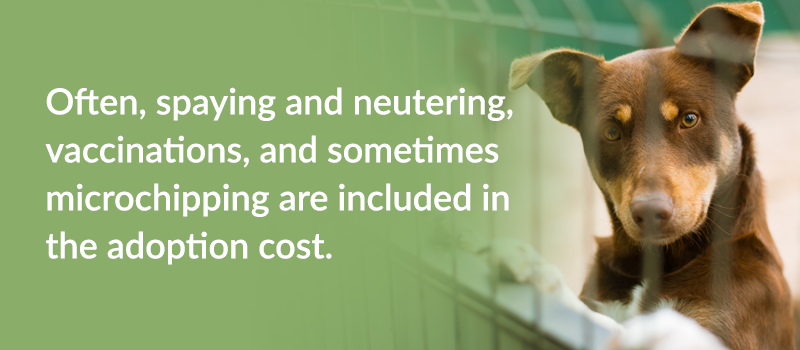
Breeders
A pet breeder is someone who owns or leases a female dog to produce litters. Before buying a pet from a breeder, visit where they are housed and raised to make sure they were brought up in a healthy environment. Though some states require a breeder to get a license to operate, other states do not. To find out if a breeder is licensed with the USDA, search the Inspection Reports Tool.
Reputable breeders make an effort to match a potential family with an individual puppy or kitten best suited for their lifestyle. They also are aware of potential health problems in their breed and screen their breeding stock to try to minimize those health problems. Many reputable breeders will have waiting lists of several months for puppies and kittens because they carefully plan breedings to optimize the health of the mothers.
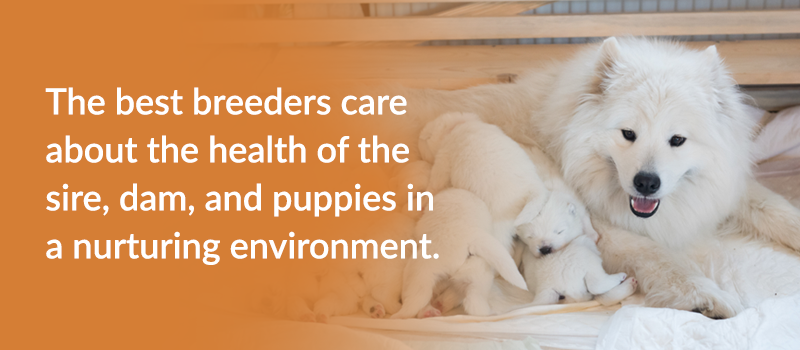
Pet Stores
Pet stores are another option when looking for a new pet. Some pet stores work with shelters to adopt out available dogs and cats. In general, however, you should use discernment when buying from a pet store. The pets in their care may have come from puppy mills, which do not provide adequate care for their dogs and cats.
What to Expect from Your New Pet
Dogs
- Establishing Routine, Patience, Enrichment, and Training - If you live with other people, work out your dog’s routine in advance with other members of your household. Discuss:
- Who will walk the dog and when
- Feeding schedules
- Possible off‑limits space in the home, like furniture or rooms
- Adjustment periods for crate training
Enrichment items, such as a stuffed treat toy or puzzle food bowl, can provide mental and physical distraction and prevent separation anxiety if you need to leave home for a while. Even if your pet is housetrained, they may still slip up as they get used to their new surroundings. Practice patience and remember to temper your expectations. Your pet will need time to adjust to you and their new lifestyle.
- The First Weeks / Socialization - Did you know that dogs instinctively like to den? A crate is a helpful tool to train your pet and can be a safe space of its own. The crate should be roomy enough to allow your dog to stand up, turn around, and sit comfortably in a normal posture. After giving time for an adjustment period, introduce your dog to other dogs while on a leash in a neutral, outdoor setting. Pay attention to each dog’s body language and allow them to pace themselves, and reward good behavior with treats (ideally, a piece of kibble from their regular food).
- Long‑term - Joining a training course can help strengthen your pet’s relationship with you by introducing positive reinforcement tips and providing time for socialization with other dogs. Playtime and exercise at home are essential for dog health, so plan walks, games, and hikes to keep them busy and satisfied. A tired dog is a good dog. Ensure that all household members appreciate that consistency and repetition are the key to training.

Cats
- Establishing Routine, Patience, and Enrichment - Set regular times for feeding, grooming, and play. You’ll also want to wait until after your cat has adjusted to introduce activities like grooming and brushing their teeth. Along with toys, scratching posts are great enrichment tools. Supplying a variety of toys and posts can give you an idea of what your cat likes. Start play sessions by calling their name in a happy voice and tossing a toy their way.
- The First Weeks / Socialization - Ease the transition to their new home by keeping your new pet separated from any other cats you may have in your home. Typically, separation should last two weeks, but be patient and allow the new cat to lead the way. You can also use this time to transition them to new food. If you adopted an older cat and you don’t know if they were in a loving home at an early age, they may need more time to adjust to their new surroundings and family members.
- Long‑term - A veterinarian can help you tackle any future behavior or medical problems with your cat, so be sure to find one you trust. Information about your cat's grooming and litter box habits will be useful in pinpointing any root issues.

Subscribe to our eNewsletter
Veterinary Care
Care for dogs
- Vaccination Schedule - Dog vaccinations are divided into two main categories: core vaccinations and non‑core vaccinations. Core vaccinations protect against common and/or particularly dangerous diseases and are recommended. Your dog’s lifestyle will need to be evaluated to determine the risk of getting infected with other diseases to receive non‑core vaccinations. Your veterinarian will know which vaccine your dog will need and when they will need to get any booster vaccinations.
- Annual Checkup - This is a great time to talk through any concerns you may have about your dog. The vet may ask you about your pet’s feeding and lifestyle habits. An annual checkup will include a nose‑to‑tail physical exam and may include:
- Vaccinations/boosters
- Bodyweight and body condition score
- Blood, urine, and fecal tests
- Coat and skin checks
- Fleas, ticks, mites, and other parasite prevention
- Dental health checks
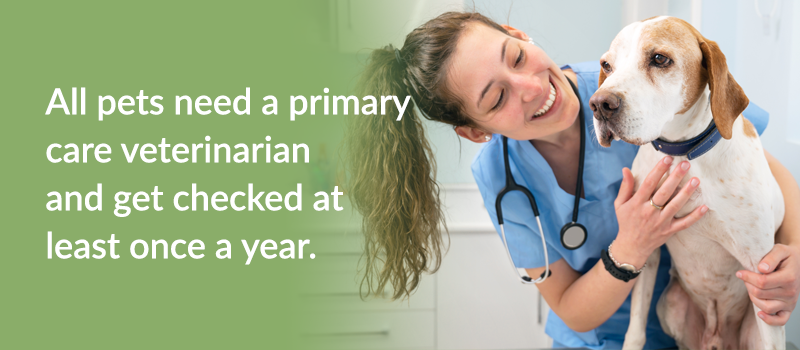
- Caring for Older Dogs - As your pet gets older, your veterinarian may recommend more frequent visits. Your dog will need an age‑appropriate, high‑quality diet and regular exercise. Large breeds tend to age faster than smaller breeds, so ask for a body condition evaluation from your vet. This will help you be able to accommodate any special needs that arise. For example, older dogs may develop arthritis and need a softer bed.
- End‑of‑Life Care for Dogs - Before the end of your dog’s life nears, talk to your veterinarian about options for end‑of‑life care. It’s best to prepare the whole family when making these decisions about whether palliative care or hospice is the best option, or if humane euthanasia is the better option.
Care for cats
- Vaccination Schedule - Cat vaccinations are divided into two main categories: core cat vaccinations and non‑core vaccinations. Core cat vaccinations protect against common and/or particularly dangerous diseases and are recommended. Non‑core vaccinations are only recommended for cats with a high risk of infection. In these cases, your cat’s lifestyle will need to be evaluated to determine risk.
- Annual Checkup - It’s recommended you bring your cat in at least once a year for a checkup; some vets suggest twice a year, especially for cats over the age of 10. Even though it can be a stressful experience for the pet, it helps if you get your cat used to getting in their carrier and going for car rides. Checkups are a good time to discuss any concerns or issues you have about your cat with the vet. Like dogs, an annual checkup will include a nose‑to‑tail physical exam and may include:
- Vaccinations/boosters
- Bodyweight and body condition score
- Blood, urine, and fecal tests
- Coat and skin checks
- Fleas, ticks, mites, and other parasite prevention
- Dental health checks
Regular checkups allow your vet to detect diseases that can develop between visits. Early detection can allow you to try treatments that can delay disease progression and vastly improve your pet’s life.
- Caring for Older Cats - As your cat ages, you’ll want to increase access to water and provide age‑appropriate food. Older cats are prone to kidney disease and constipation. Also, consider creating more accessible mobility options that will be easier on their joints. Have a litter pan and water on each floor of your home. Carpeted cat ramps and comfier beds will give them soft places to climb and rest.
- End‑of‑Life Care for Cats - Some cats will reach the age of 20. It’s best to prepare the whole family when making these decisions about palliative care, hospice care, or humane euthanasia. Talk to your veterinarian about options for end‑of‑life care and what your family’s wishes are.
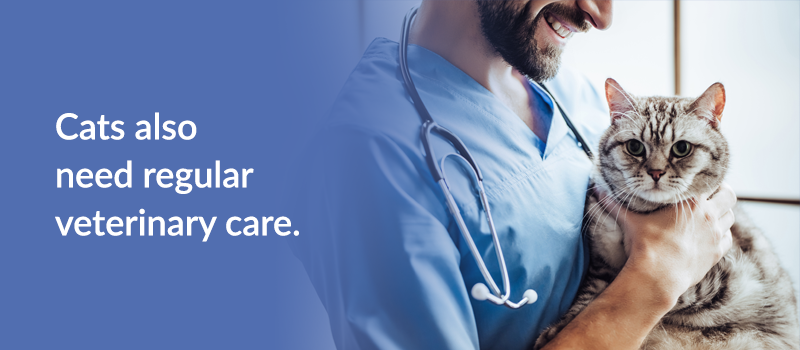
Paying for Care
Veterinary costs are often unexpected financial burdens. If your dog or cat gets sick, you want to be there for them and not have to worry about how you’ll pay for care. Fortunately, there are many payment options available to you to cover costs.
- Payment is expected the day your pet receives care.
- Consider getting pet healthcare insurance while your pet is young and healthy. Ask your veterinarian which companies they suggest and contact your insurance broker or a pet insurance broker like Fursure to help you decide which plan is best for your situation.
- Most veterinary clinics accept credit cards (Visa, MasterCard, Discover, American Express), checks, and cash. If you're not sure if they'll accept the kind of payment you plan to make, ask the veterinary clinic ahead of time.
- Your clinic may provide CareCredit as an option to cover costs. Applying for the program takes just five minutes and breaks your payment into six monthly installments. You can apply at their hospital, where the office staff will call in your application over the phone for immediate approval, or apply online yourself on their website. Pay on time or risk heavy fines.
- There may be other third‑party payment plans available if you don’t qualify for CareCredit. Not all veterinary clinics offer payment plans.
- Donations to One Health Organization help to fund Vouchers that some veterinary clinics accept as payments from our One Health Family Members. Here are the veterinary partners that have agreed to accept Vouchers from our members.
This Pet Parent’s Guide to Caring for Your Dog or Cat is designed to prepare you for every aspect of your new pet decision. We hope this guide will help remove the guesswork of wondering what life will be like when you add a dog or cat to your household. Your new companion is sure to fill your days with unconditional love and affection.
.jpg?width=510&height=660&name=pet-parents-guide-to-caring-for-your-dog-or-cat-Download-Cover-510x660%20(1).jpg)

